10 unexpected things I did in the first two hours of The Division
Christmas is cancelled
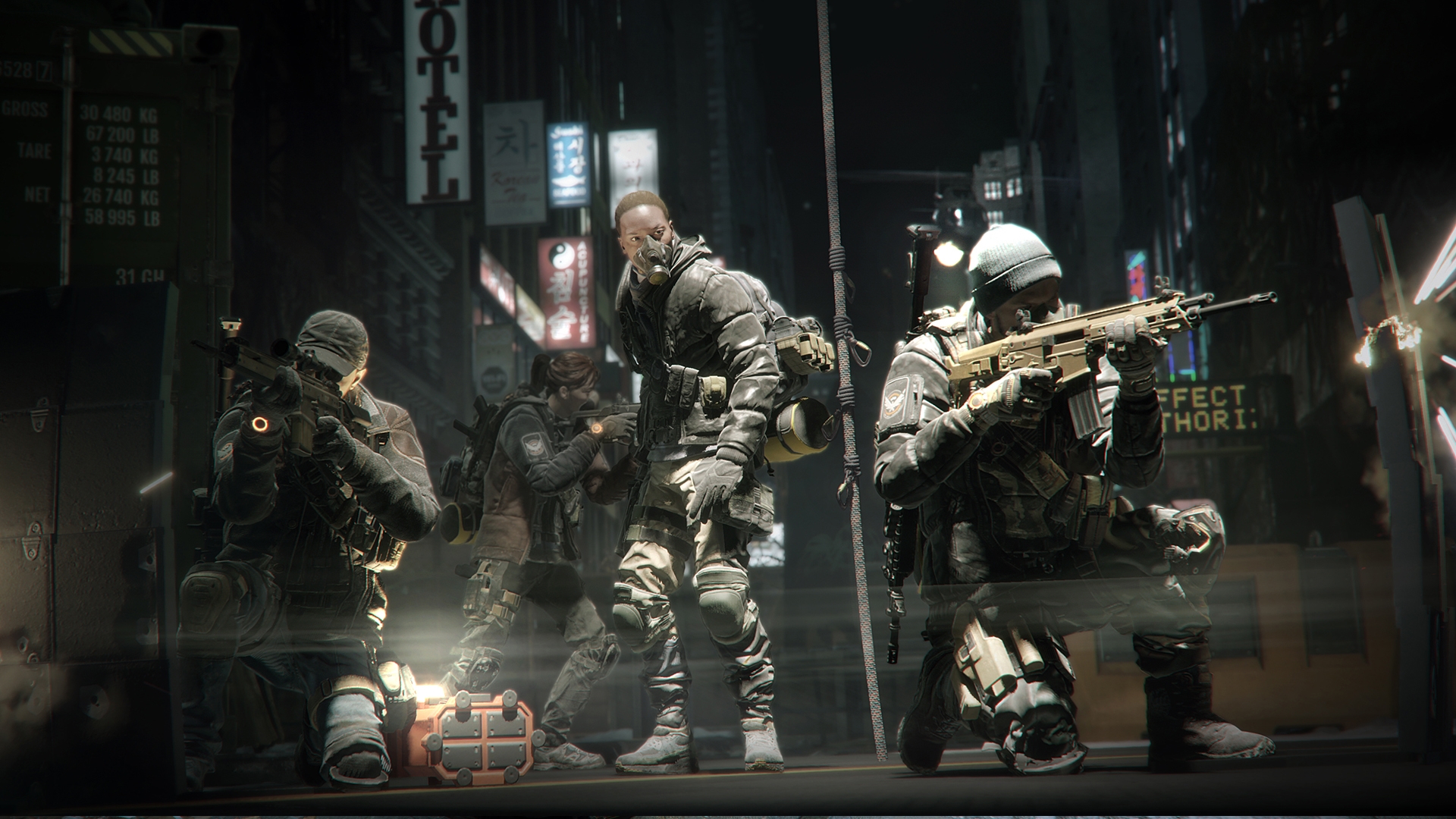
As if you needed another reason to stay at home on Black Friday. In Tom Clancy's The Division, the world is brought to its knees by a bio-terrorist attack on the biggest sales day of the year, where contaminated $20 bills spread a fatal virus faster than you can say '50% off'. Now, New York City is in a state of crisis, and it's up to you and a ragtag crew of agents to take back the barren, snow-covered streets from rioters, escaped convicts, and deranged government workers wielding flamethrowers.
After playing The Division for a solid two-and-a-half hours, I'm getting a distinct Destiny vibe - and as you Guardians already know, that's a very good thing. Like Bungie's console megahit, The Division takes a familiar action framework - third-person cover shooting, in this case - and melds it with the online open-world and RPG progression typical of your classic MMO. It's too early to say if Ubisoft's vision of a mid-apocalypse NYC can topple Bungie's space epic FPS, but judging by these things I did during my playtime, I think it's got a shot at being your next nightly obsession.
1. Created a do-anything character
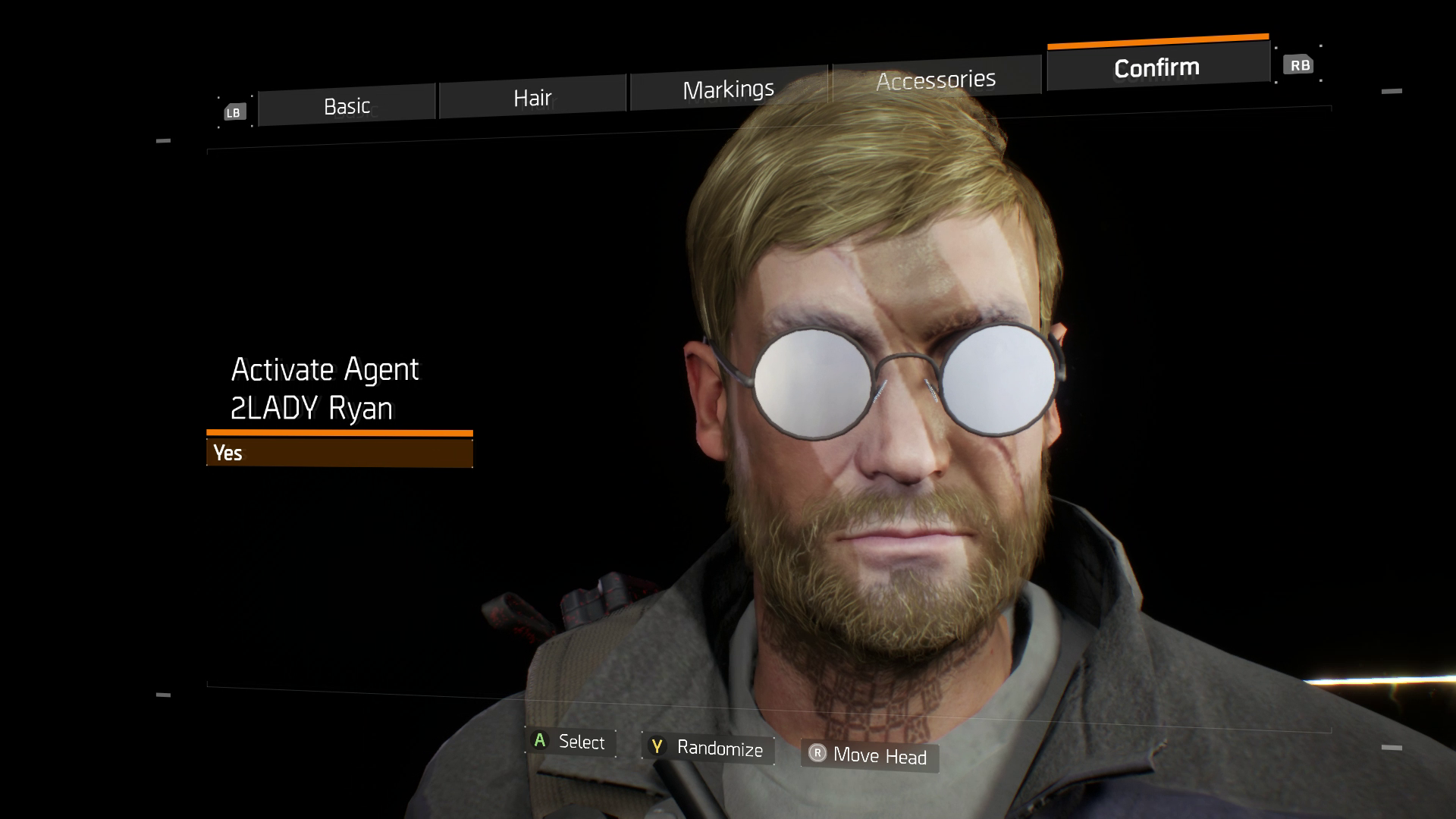
You can't be expected to invest thousands of hours into an online game without some control over what your avatar looks like, and The Division's character creator is perfectly serviceable. You can play as either a male or female agent - doesn't seem to make a difference, as I never saw my character speak - with the typical assortment of faces, hairstyles, and accessories. After crafting a soldier who looks like a cross between a rugged commando and a nerdy scientist with a regrettable neck tattoo, my agent 2LADY RYAN (as decided by my demo station) was ready to restore order to the Big Apple one covert op at a time.
What's unique about The Division is that there are no set classes; every player has access to the same three ability trees, and can respec whenever they so choose. Your abilities are what dictate your role - healing and scouting support, tech-deploying aggressor, frontline defender, or some mixture of the three - but having the freedom to switch gears at will is pretty enticing. If you're itching for a new playstyle, all you have to do is rearrange some Skill points, rather than remake an entirely new character.
2. Tricked out my weapon with enhancement mods

My agent entered NYC via chopper, with a woman by the name of Faye Lau as my point of contact. Much as she'd like to, Lau can't join the fight due to extensive wounds, but offers intel and a constant throughway to story missions via your earpiece. Once I set my boots on the frosty ground, I did what any MMO player would: popped open my inventory to see what I was packing. This may have been an effect of the demo build, but my agent was already loaded with an assortment of tantalizing starter weapons, and more importantly, a full suite of enhancement mods.
Each firearm, be it an assault rifle, shotgun, or machine gun, comes with a number of customizable slots for various add-ons (all of which change the look of your gun, naturally). I opted to kit out my ACR with the works - an extended magazine for more ammo, a reflex sight for better range, a handstop for increased accuracy, and so forth. Every piece of equipment comes with clearly displayed stats, including some that'll be familiar to MMO veterans; for instance, equipping a suppressor provided reduced threat (the likelihood that my fire will draw enemies' attention), while my scope granted additional XP on headshot kills.
3. Aimlessly wandered around an empty New York City
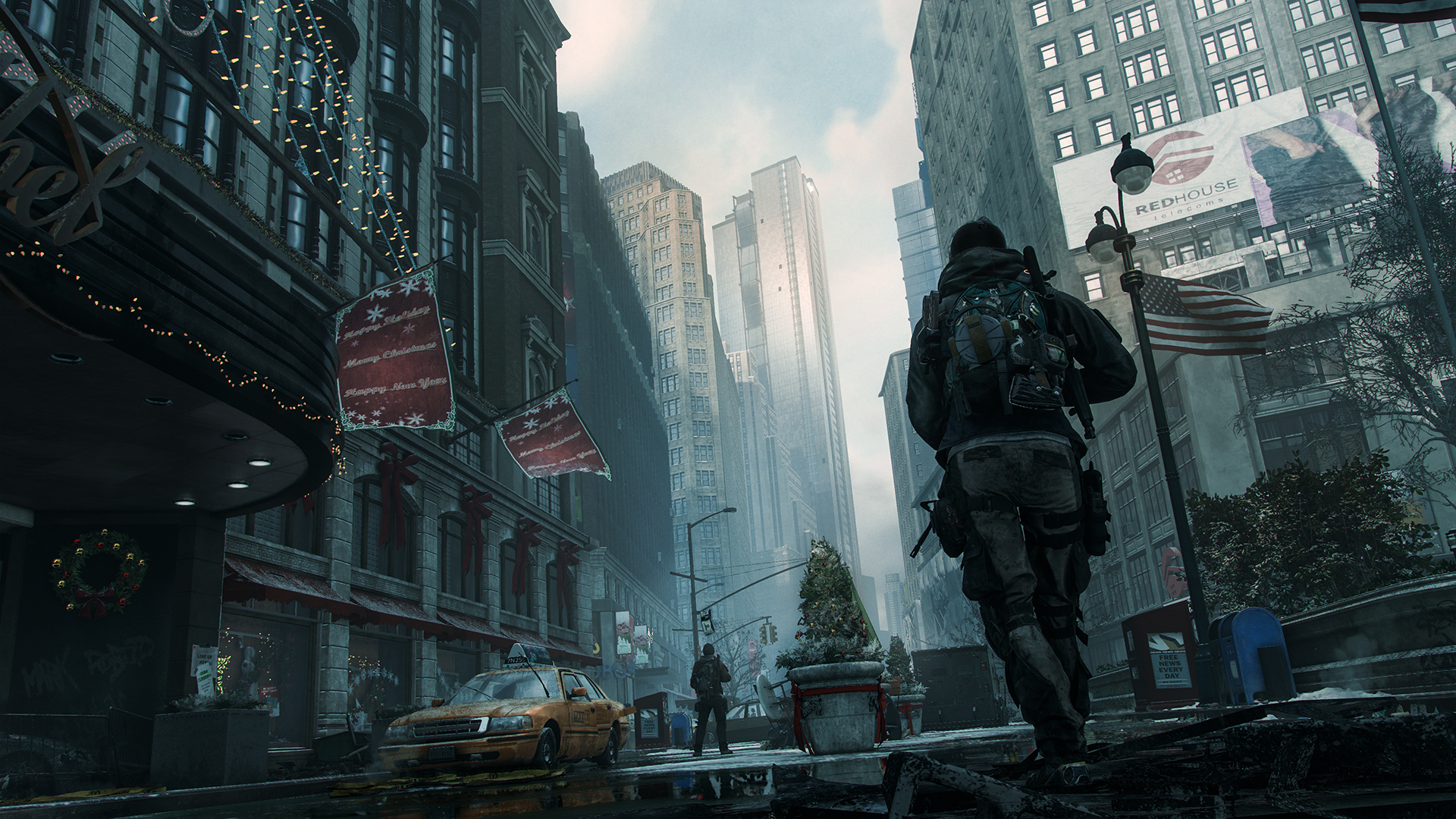
If you've ever been to NYC, then you know how densely packed it is - which makes exploring its desolate streets in The Division a uniquely eerie experience. Think I Am Legend, but with a lot more snow and Christmas decorations strewn about. Ubisoft is striving for the most faithful recreation of New York City yet seen in a game, with real-life landmarks in every direction and ample amounts of graffiti.
Weekly digests, tales from the communities you love, and more
Because the entire city's under quarantine, you'll only encounter a few civilian NPCs mixed in with the chaos-thriving goons that litter the streets. While most of the open-world action takes place on the grid-like roads, I was able to explore a handful of abandoned buildings, including one with a locked door requiring a pick I sadly didn't have. On the rare occasion that I encountered other players, my three-person squad (four players being the maximum party size) displayed the universal emote of peace: jumping jacks. During my wanderings, I even spotted a poor, mangy mutt relieving itself in the middle of the street. Oddly, you can gun down dogs (I'm so, so sorry, Rex), but shooting at NPCs does nothing other than frighten them.
4. Encountered my first elite enemy
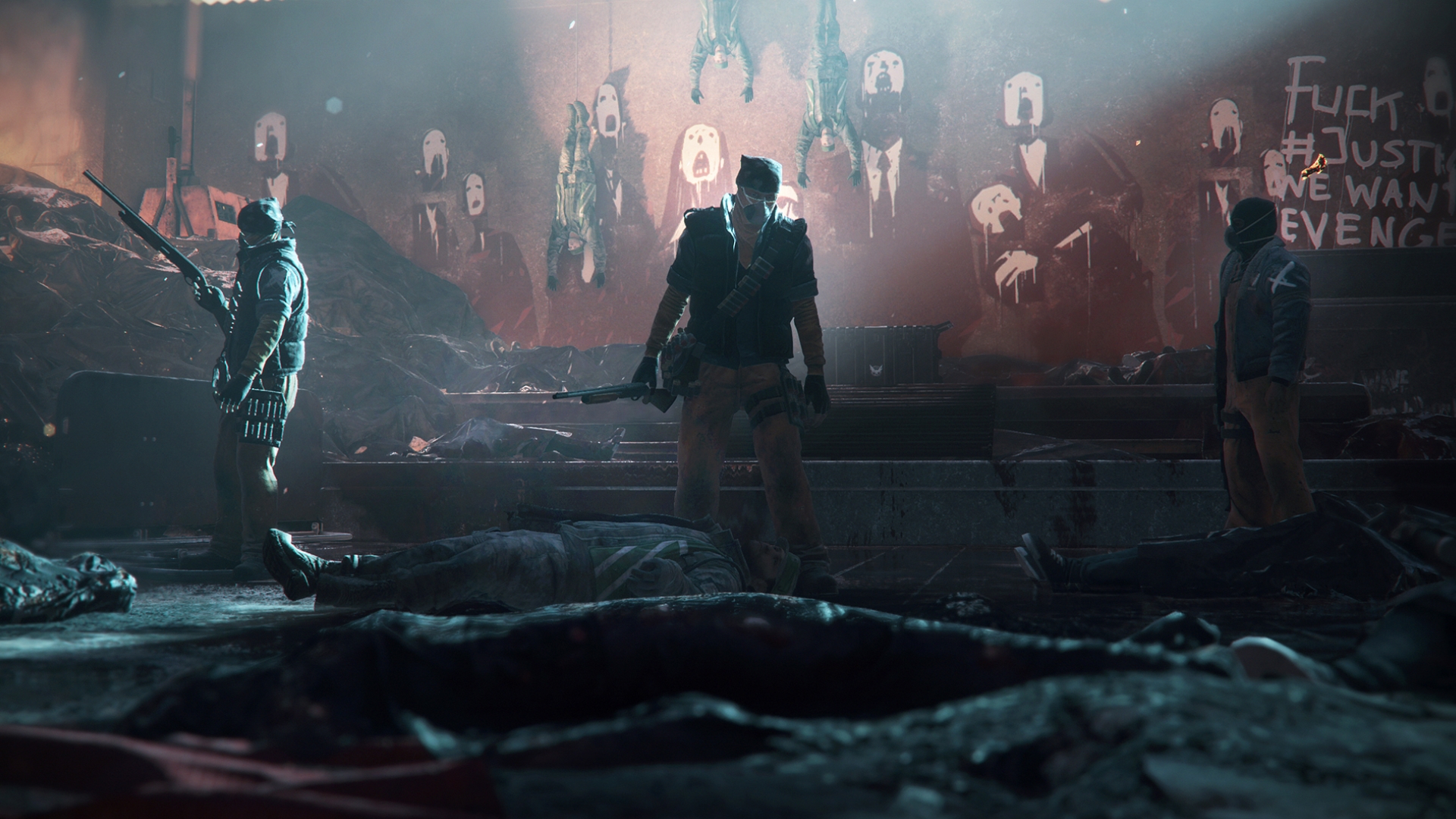
There are three factions of baddies in The Division, all of whom hate you as much as they hate each other. You've got generic rioters preying on innocents in the streets; Rikers, brutal escaped convicts from Rikers Island who still haven't changed out of their orange jumpsuits; and Cleaners, blue-collar custodians who decided to purge the entire outbreak one flamethrower-cooked body at a time.
The time it takes to kill garden-variety fodder in The Division initially feels a bit strange. Given that this is an action RPG with an emphasis on team play (though going solo is very much an option), enemies take more hits to kill than you might expect from a typical third-person shooter. There will be instances where you've unloaded an entire clip into a random thug in a t-shirt and jeans, and he'll still be left standing there shooting at you with just a pinch of health remaining. But when you butt heads with an elite enemy decked out in body armor, that slow time-to-kill makes a bit more sense. The particular elite mob I encountered was a rioter simply named Poole, who had a yellow health bar instead of the typical green and who flung grenades that forced me to dive between cover or be incinerated.
5. Established a Base of Operations

After following Faye Lau's orders and weeding out some gun-toting riff-raff, I was able to take back the Midtown South Precinct and make it my Base of Operations, a main hub that acts as a sanctuary in the middle of NYC's crisis. When you first establish your footing there, it's little more than a run-down ruin. But as you complete missions, you'll gather the resources you need to rebuild its three main wings: Medical, Technical, and Security.
These three specialties mirror the three tech trees for your character, and each comes with its own storyline and central characters to recruit and assist in the fight against the virus. Upgrading divisions within each wing unlocks a new set of perks for your character, which can be hugely beneficial; my favorite is one that gives headshots a 50% chance to not expend a bullet. You'll also find some generic vendors keeping you company along with the story NPCs; otherwise you'd be all alone in this instanced area. There's also a crafting bench for building new weapon enhancements, though I wasn't lucky enough to score any blueprints during my playtime.
6. Had a massive shootout on the court at Madison Square Garden

Once I had established a Base of Operations, my first order of business was rescuing a doctor who might know how to treat the virus. She was being held hostage by a gang of armed thugs inside Madison Square Garden, which itself had been transformed from a basketball stadium into a makeshift hospital when the outbreak started. This was but one of many available missions, even at such an early point in the game; one look at the map, and it's clear that The Division's open-world has no shortage of main and side-quests that need completing in whatever order you see fit.
The layout of MSG offered a nice variety of shootouts, taking us across the court in a wide-open firefight against waves of rioters, up to the rafters for some close-quarters combat (including zealous enemies who charge at you with baseball bats), then finally onto the roof for an all-out assault to reach the only remaining escape route. The enemy AI seems fairly standard so far; thugs will take cover and try to flank you as soon as you open fire, though a few idiotic goons will try capping you while standing in plain sight. At my relatively low level, tight teamplay doesn't seem particularly necessary, though it's always helpful.
7. Found my ideal Skill set
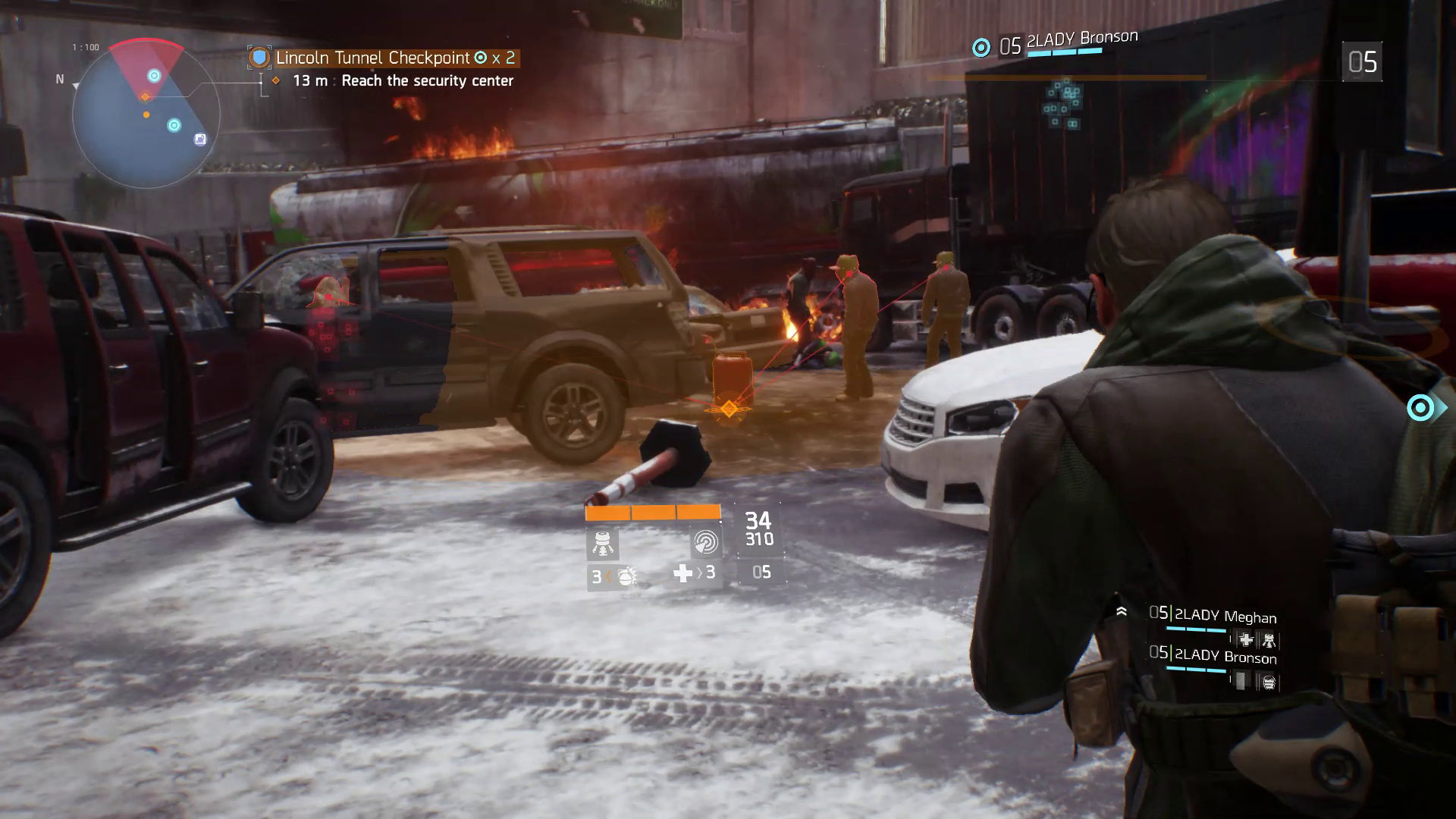
After plugging enough rioter skulls, my agent reached level 5, at which point a second Skill slot unlocks. The Division spices up gunplay with three main abilities available at level 30, the current cap; two basic power-ups and a ultimate that's unlocked much later down the line. My preferred loadout pairs the Medical tree's Pulse ability (scan for enemies in a huge radius, tagging them even through walls and giving your allies a buff to critical hits) with the Tech ability Sticky Bomb (which lets you launch a wad of remote-detonated C4 at some unlucky sap). This let me set up the perfect opener every time: scan for targets, then announce my arrival with a well-placed explosive on the nearest clump of baddies.
Of course, I'm sure I'll change this optimal loadout countless times on the path to the level cap, which is the beauty of The Division's mix-and-match skillset. Other abilities include a Ballistic Shield that you can use with your infinite-ammo pistol, an AOE heal, a deployable turret, and a way to enhance cover so that it buffs all adjacent teammates. To add further variety, there are Talents you can spec (up to four) that enhance these Skills, plus Perks that act as limitless passive buffs based on how you've upgraded your Base of Operations. It sounds like a lot to take in, but it should go a long way towards making your agent feel distinct.
8. Stumbled upon some hidden lore
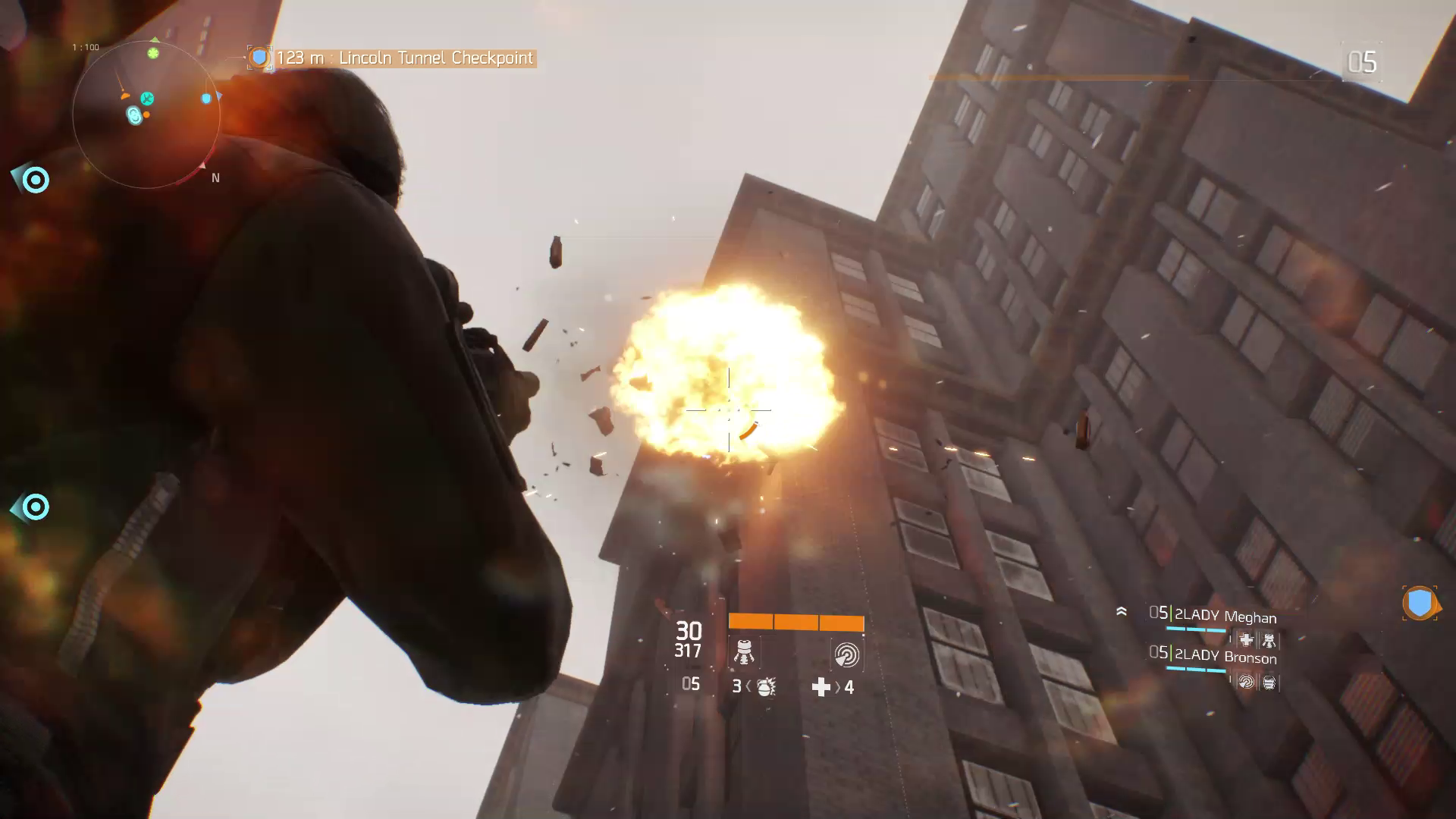
On our way to a mission set inside the Lincoln Tunnel, my squad took a little detour when we heard a mysterious buzzing. By tracking the strange noise to its source, we found a military drone lodged in the corner of a building. Shooting it down unlocked a nifty bit of intel about the virus outbreak: a thermal imaging shot of a crowd of rioters as they assaulted a government outpost with limited medical supplies.
Pieces of collectible Intel are scattered throughout the city, offering bits of lore in a multitude of forms - anything from a blurb of text to a full-blown security camera cutscene. Some are unlocked once you've completed missions; others you can simply find, like the crashed drone or a note I received after giving a spare med kit to an injured civilian. It's unclear if Intel has any direct benefit to your character's power, but it does an excellent job at building up the Tom Clancy mythos and the logistics of how this outbreak could actually occur. Here's a fun, disconcerting fact: The Division was inspired by a real-life simulation called Operation Dark Winter, in which the US government discerned that America was woefully unprepared for biological terrorist attacks like weaponized smallpox.
9. Finally set foot in the Dark Zone

The Dark Zone is like the Wild West of mid-crisis NYC, an unconquered territory where the only law is your gun. Ok, maybe I'm romanticizing it a bit - but it's a pretty intriguing way to handle PvP showdowns when all the Division agents are supposed to be on the same justice-enforcing side. Venturing into the Dark Zone makes you vulnerable to hardened NPCs and other players alike, and is almost treated like a separate region entirely: you're given a separate DZ level upon entering, and the only way to keep the gear you score within the Dark Zone is surviving an extraction (more on those in a bit).
If you're feeling particularly murderous, you're free to kill each and every player or baddie you encounter - but the moment you blast lead at a player-controlled character, you and your entire team will be temporarily disavowed by the Division and marked as Rogue agents. The Rogue system acts like the karma mechanic you might've encountered before in PvP-centric MMOs: kill more players, and you become more notorious, meaning greater rewards for you if you survive until the Rogue label wears off, or bigger XP and loot payouts for others if they successfully put a bullet through your skull.
10. Avenged my dead teammates with a shotgun execution
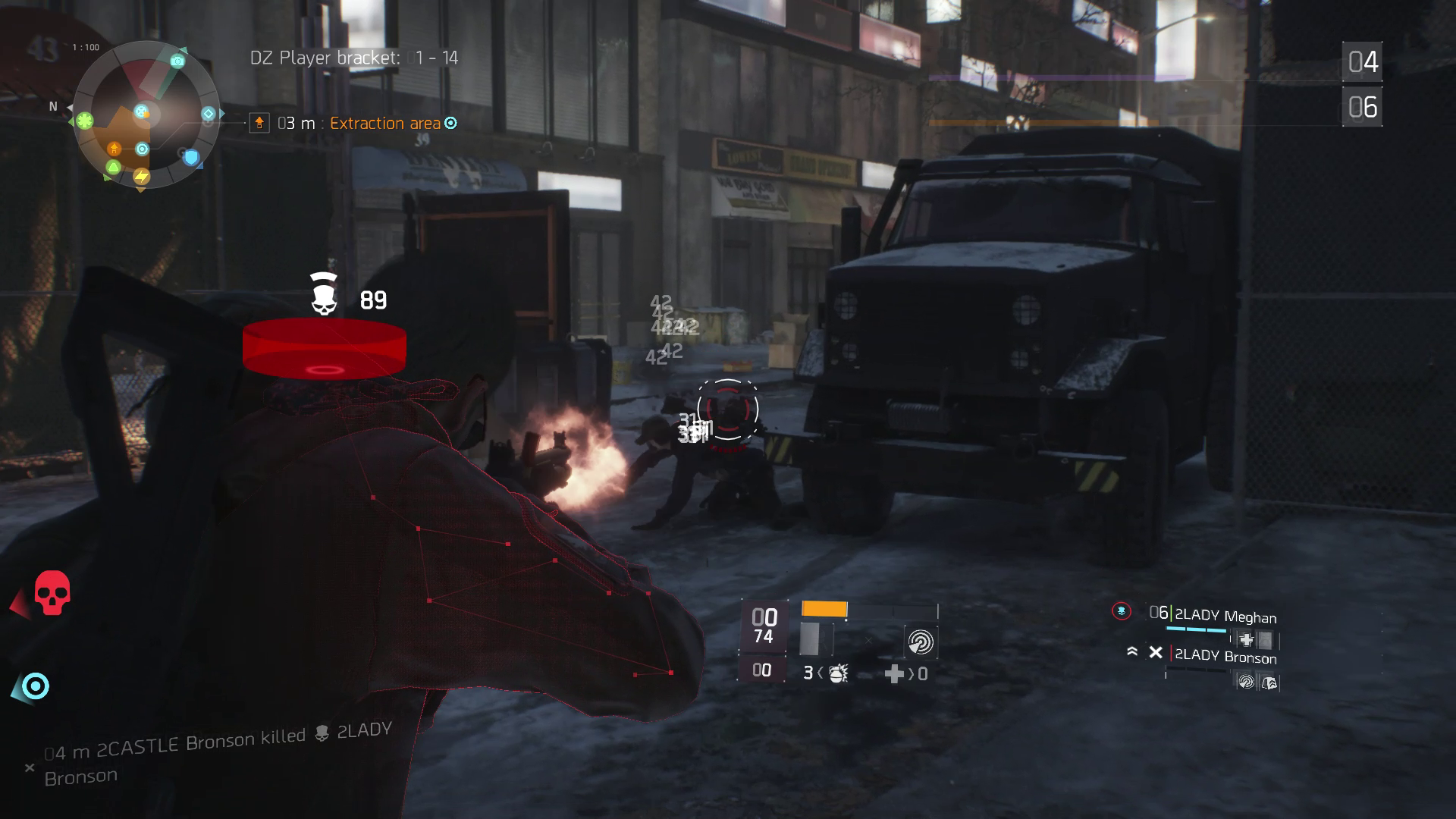
Life in the Dark Zone can be as cooperative or chaotic as you make it. Initially, my squad made peace with the other players we encountered, helping them decimate waves of AI thugs as we all increased our DZ level. As your DZ level increases, you'll gain access to better loot crates scattered throughout the desolate area - but you'll also be worth more XP to bloodthirsty players. And in the Dark Zone, you can actually lose XP and drop your shiny new loot if you get killed before you can extract the goods in time.
Extracting gear is an incredibly tense process: you need to call in a helicopter that takes 90 seconds to arrive, then hope you can survive another 60 seconds while your loot is being airlifted out. The catch is that pretty much everyone in the general vicinity can see what you're doing - especially at night, what with the chopper's blindingly bright spotlight - with the full knowledge that now would be the perfect time to kill you and take your gear at the last second. The temptation was too great for some of our would-be allies, and a giant firefight broke out between my squad, our former cohorts, and a third party that happened to stumble into the fray. My teammates paid with their lives to have our gear successfully extracted, but I managed to avenge their deaths with a shotgun blast to our aggressor's face and a melee thumping with the butt of the gun to finish him off. It was a fitting ending to the demo, and exciting look at the kinds of war stories that should inevitably emerge from the anarchic nature of the Dark Zone.
Lucas Sullivan is the former US Managing Editor of GamesRadar+. Lucas spent seven years working for GR, starting as an Associate Editor in 2012 before climbing the ranks. He left us in 2019 to pursue a career path on the other side of the fence, joining 2K Games as a Global Content Manager. Lucas doesn't get to write about games like Borderlands and Mafia anymore, but he does get to help make and market them.



